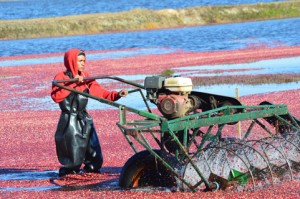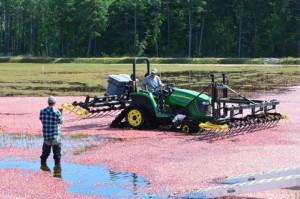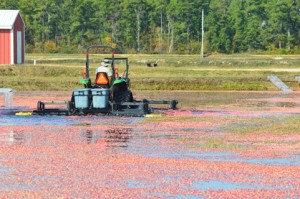Pine Island Cranberry always works toward doing what we do better every day. We’ve been working very hard to bring this year’s crop in with some new machinery…but we still have a crew out there with the older equipment, doing whatever it takes to finish their work!
Supervisor Jeremy Fenstermaker’s Green Team is out at Mike Hensel right now, using the old reel harvesters to knock berries off the vines. “Usually, we use the Gates Harrow on level bogs, or bogs with only one or two big picking patterns,” Jeremy says. (Each bog is picked in a specific pattern according to terrain, and the picking crew has to carefully move their harvesters around stakes which have been arranged by the team leader for maximum operational efficiency. Following this pattern allows for minimal damage to the vines.) “These bogs are older; they have ditches and aren’t very level, so we have to pick them with the reels. You need a guy leading to show where they’ve already picked. With the Gates Harrow, the water has to be low enough that Rick [Zapata] can use the fruit for a guide. With these bogs being so out of level, we can’t hold the water low enough for Rick to see where he’s picked already.”
So, while Rick is over helping next door at the Sooys’ operation (“Those bogs are nice and level, and the Sooys are great neighbors”), Jeremy reflects on some of the differences between the traditional reel harvesters and the Gates Harrow machines. “Using the Gates Harrow frees up a lot of people to do other work that needs to get done. It’s moves a lot faster, too; the only problem is you have to pick ahead so you can get the timing right for gathering and keep the water flowing.” He also thinks the new machines pick a lot cleaner than the regular ones. “I think there’s less damage to fruit with the Gates Harrow; it combs the berries off vines, which makes harvest easier on vines, as well.”
Having the additional machine still makes things easier for a crew using the traditional reel harvesters. “It’s nice having two this year,” Jeremy says. “With two you can keep three crews running smoothly with no hold-ups getting the fruit to the packing house. It works out very well.”




